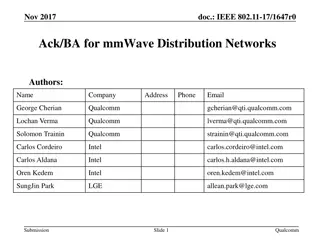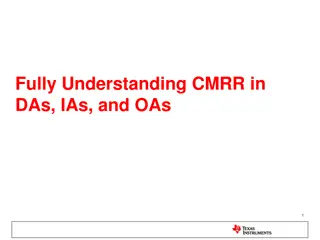Simplifying IMMW Adoption through DL-Only Mode in mmWave Technology
Promoting the adoption of Integrated Multi-band and Multi-Wavelength (IMMW) technology through the implementation of a DL-only mode in mmWave devices. This approach addresses challenges such as coverage mismatch, power consumption, and cost, potentially increasing the number of IMMW user devices and driving overall adoption. The proposal emphasizes the benefits and feasibility of supporting DL-only operation in mmWave for enhanced connectivity and user experience.
Download Presentation

Please find below an Image/Link to download the presentation.
The content on the website is provided AS IS for your information and personal use only. It may not be sold, licensed, or shared on other websites without obtaining consent from the author.If you encounter any issues during the download, it is possible that the publisher has removed the file from their server.
You are allowed to download the files provided on this website for personal or commercial use, subject to the condition that they are used lawfully. All files are the property of their respective owners.
The content on the website is provided AS IS for your information and personal use only. It may not be sold, licensed, or shared on other websites without obtaining consent from the author.
E N D
Presentation Transcript
May, 2024 doc.: IEEE 802.11-24/0823r1 Further Simplifications To Promote IMMW Adoption Date: 2024-05-08 Authors: Name Bilal Sadiq Affiliations Samsung Electronics Address Phone email bilal.sadiq@samsung.com Vishnu V. Ratnam Rubayet Shafin Peshal Nayak Yue Qi Boon L. Ng Submission Slide 1 Bilal Sadiq, Samsung Electronics
May, 2024 doc.: IEEE 802.11-24/0823r1 Abstract Amendment should also support a simpler IMMW user-device that may operate in DL-only (RX-only) mode in mmWave At times, capability of an IMMW user-device will get reduced to DL-only (RX- only) operation in mmWave, for various reasons A simpler IMMW user-device without mmWave TX hardware may prove a catalyst for IMMW adoption non-AP-MLD AP-MLD Common MAC DL Common MAC sSTA sSTA MAC SAP MAC SAP UL DL mSTA mSTA UL temporarily disabled Or TX not implemented at non-AP mSTA Submission Slide 2 Bilal Sadiq, Samsung Electronics
May, 2024 doc.: IEEE 802.11-24/0823r1 Many arguments already presented are also valid arguments for DL-only mode in mmWave 23/1819r0 success of integrated 802.11 systems depends significantly on the ability to offset the substantial area and complexity of mmWave RF/antenna technology. Reduce power consumption, support asymmetric links, push higher complexity to AP 23/1905r0 commercial success of IMMW technology depends on whether complexity, cost and power consumption are given high priorities in the design 23/2004r0 limited scope is critical to minimal implementation complexity and larger market adoption 24/0066r0 collaborative operation between sub-7 GHz and mmWave bands may be one of the most important factors 23/1977r1, 24/0008r2 Some of the demanding applications and use-cases are naturally DL heavy (projector, display, dock) Submission Slide 3 Bilal Sadiq, Samsung Electronics
May, 2024 doc.: IEEE 802.11-24/0823r1 Motivation Why support a DL-only mode in mmWave: 1. Large DL vs UL coverage mismatch in mmWave 2. MPE* requirements will at times force further mmWave UL power reduction, essentially prohibiting UL in mmWave E.g., based on user grip or location in proximity to the TX array 3. Significant cost, power consumption, and area to add mmWave TX chains As a byproduct of removing TX chain, slight improvement in RX (~1.5dB) due to removal of T/R switch 4. Some applications and use-cases that motivate IMMW are naturally DL heavy (projector/TV/display, dock) 5. Supporting user devices with RX-only in mmWave could be a stepping stone to IMMW success, increasing number of IMMW user devices, thus promoting adoption of IMMW on AP side too. Submission Slide 4 Bilal Sadiq, Samsung Electronics *MPE: Maximum Permissible Exposure
May, 2024 doc.: IEEE 802.11-24/0823r1 1. Large DL vs UL coverage mismatch in mmWave Assume AP has 8x 16x larger antenna array than mobile STA E.g., AP array ? ?= 8x16 or 8x32 vs STA array ? ?= 8x2 [1] Same total array gain in DL and UL, but higher transmit power in DL ??: ????,?? + 10log ? ? + ???+ 10log ? ? + ????+ 10log ? ? ??: ????,???+ 10log ? ? + ???+ 10log ? ? + ????+ 10log ? ? Total TX power Total array gain between AP & STA UL link budget 9dB 12dB worse than DL That s with optimistic assumption that AP & STA have similar PAs In terms of distance: Assume ?? ? = ????? + 3.5 10log10? [2][3] Given, ?? ???,??? ?? ???,??? = 9?? DL coverage UL coverage ???,??? 2 ???,??? Or about 1 interior wall crossing Sub-7 coverage Submission Slide 5 Bilal Sadiq, Samsung Electronics
May, 2024 doc.: IEEE 802.11-24/0823r1 2. Further UL power reduction due to MPE Compliance with mmWave exposure (mW/cm2) standards requires STAs to limit time-averaged and spatial peak exposure [4] [6] Narrow beams (~10 20 ) + STAs used in vicinity of humans/handheld Further reduction in TX power when main lobe or even side-lobe illuminates nearby humans (any proximal reflectors) Required power reduction can be quite drastic, essentially disabling UL [7][8] Typically, switching is exploited to get around the ~1mW/cm2 time-averaged limit (e.g., [10]) Even though mmWave permits high spatial reuse as noted by many submissions, UL channel access may get bottlenecked by switching to meet MPE limits Submission Slide 6 Bilal Sadiq, Samsung Electronics
May, 2024 doc.: IEEE 802.11-24/0823r1 3. Cost, power consumption, area Consensus on OFDM-based PHY (more or less) 60GHz PA efficiency @ 8dB backoff <10% Thermal regulation challenges for mobile form factor ~75% higher power consumption in mmWave vs sub-7 (for same bandwidth) [9][1,2] Removing TX chains can bring significant cost reduction Assuming 2 chains per module (x-polarized array) and 2 modules on different facets of the device (for rudimentary spherical coverage) 2 high BW DACs, 4 mixers, 4MN phase shifter, PAs, T/R switches Lower cost, power consumption, area/complexity will reduce barrier to IMMW adoption In particular for DL-heavy devices and applications Submission Slide 7 Bilal Sadiq, Samsung Electronics
May, 2024 doc.: IEEE 802.11-24/0823r1 Conclusion 1. Third time s a charm? Are we sure? 2. From previous attempts at mmWave, we ve learnt that NSA (Non- StandAlong) is perhaps the key, as already captured in PAR draft 3. Now we better use this key to (at least) design a Minimum Viable System We need to use NSA to get around the limitations of mmWave UL, so that IMMW can be adopted for mainstream use-cases Submission Slide 8 Bilal Sadiq, Samsung Electronics *MPE: Maximum Permissible Exposure
May, 2024 doc.: IEEE 802.11-24/0823r1 Straw Poll The IMMW non-standalone operation should also support a DL-only mode in mmWave. Yes, No, Abstain Submission Slide 9 Bilal Sadiq, Samsung Electronics
May, 2024 doc.: IEEE 802.11-24/0823r1 References [1] 15/0866r4, 11ay Evaluation Methodology [2] 14/0882r4, 11ax Channel Model Document [3] 3GPP TR 38.901, Study on channel model for frequencies from 0.5 to 100 GHz [4] C95.1-2019 - IEEE Standard for Safety Levels with Respect to Human Exposure to Electric, Magnetic, and Electromagnetic Fields, 0 Hz to 300 GHz [5] ICNIRP. Guidelines for limiting exposure to electromagnetic fields (100 kHz to 300 GHz). Health Phys 118(00):000 000; 2020 [6] FCC-19-126A1 [7] He et al., Implications of Incident Power Density Limits on Power and EIRP Levels of 5G Millimeter-Wave, IEEE Access, 2020 [8] 3GPP TS 38.321 (See MPE P-MPR in Power Headroom Report) [9] 3GPP TR 38.840, Study on User Equipment (UE) power saving in NR [10] Qualcomm Smart Transmit Slide 10 Submission Bilal Sadiq, Samsung Electronics
May, 2024 doc.: IEEE 802.11-24/0823r1 APPENDIX Submission Slide 11 Bilal Sadiq, Samsung Electronics
May, 2024 doc.: IEEE 802.11-24/0823r1 PAR text proposal (TBD) Sample new text in PAR: The amendment requires that an 802.11 device supporting this amendment also supports at least one of the 2.4 GHz to 7.25 GHz (sub-7 GHz) unlicensed bands. The amendment expands the multi-link operation defined in the sub-7 GHz band specifications to support non-standalone operation in the unlicensed bands between 42 GHz and 71 GHz. The non-standalone operation includes support of a DL-only operation in the unlicensed bands between 42 GHz and 71 GHz. Submission Slide 12 Bilal Sadiq, Samsung Electronics























